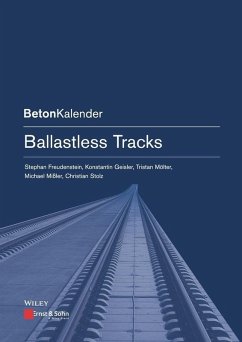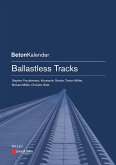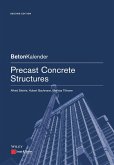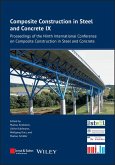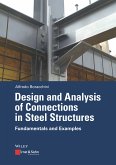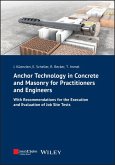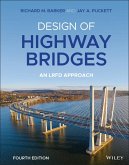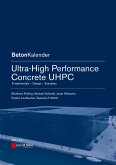Ballastless Tracks (eBook, PDF)


Alle Infos zum eBook verschenken

Ballastless Tracks (eBook, PDF)
- Format: PDF
- Merkliste
- Auf die Merkliste
- Bewerten Bewerten
- Teilen
- Produkt teilen
- Produkterinnerung
- Produkterinnerung

Hier können Sie sich einloggen

Bitte loggen Sie sich zunächst in Ihr Kundenkonto ein oder registrieren Sie sich bei bücher.de, um das eBook-Abo tolino select nutzen zu können.
Angesichts der zunehmenden Verkehrsdichte und -lasten auf Schienenwegen einschl. Tunnelbauwerken sowie des Ausbaus der Hochgeschwindigkeitsnetze weltweit kommt die Betonbauweise der Festen Fahrbahn zunehmend zum Einsatz. Nach ersten Erprobungen in den 1970er-Jahren und mehr als vier Jahrzehnten Forschungs- und Entwicklungsarbeit auf dem Gebiet der Festen Fahrbahn wurde ein Entwicklungsstand erreicht, der die Anwendbarkeit der Festen Fahrbahn als Alternative zum Schotteroberbau bestätigt. Dieses Buch spiegelt den aktuellen Stand der Technik der Festen Fahrbahn wider und beschreibt die…mehr
- Geräte: PC
- mit Kopierschutz
- eBook Hilfe
- Größe: 21.39MB
![Ballastless Tracks (eBook, ePUB) Ballastless Tracks (eBook, ePUB)]() Stephan FreudensteinBallastless Tracks (eBook, ePUB)52,99 €
Stephan FreudensteinBallastless Tracks (eBook, ePUB)52,99 €![Precast Concrete Structures (eBook, PDF) Precast Concrete Structures (eBook, PDF)]() Alfred SteinlePrecast Concrete Structures (eBook, PDF)79,99 €
Alfred SteinlePrecast Concrete Structures (eBook, PDF)79,99 €![Composite Construction in Steel and Concrete IX (eBook, PDF) Composite Construction in Steel and Concrete IX (eBook, PDF)]() Composite Construction in Steel and Concrete IX (eBook, PDF)151,99 €
Composite Construction in Steel and Concrete IX (eBook, PDF)151,99 €![Design and Analysis of Connections in Steel Structures (eBook, PDF) Design and Analysis of Connections in Steel Structures (eBook, PDF)]() Alfredo BoracchiniDesign and Analysis of Connections in Steel Structures (eBook, PDF)61,99 €
Alfredo BoracchiniDesign and Analysis of Connections in Steel Structures (eBook, PDF)61,99 €![Anchor Technology in Concrete and Masonry for Practitioners and Engineers (eBook, PDF) Anchor Technology in Concrete and Masonry for Practitioners and Engineers (eBook, PDF)]() Jürgen KüenzlenAnchor Technology in Concrete and Masonry for Practitioners and Engineers (eBook, PDF)79,99 €
Jürgen KüenzlenAnchor Technology in Concrete and Masonry for Practitioners and Engineers (eBook, PDF)79,99 €![Design of Highway Bridges (eBook, PDF) Design of Highway Bridges (eBook, PDF)]() Richard M. BarkerDesign of Highway Bridges (eBook, PDF)144,99 €
Richard M. BarkerDesign of Highway Bridges (eBook, PDF)144,99 €![Ultra-High Performance Concrete UHPC (eBook, PDF) Ultra-High Performance Concrete UHPC (eBook, PDF)]() Ekkehard FehlingUltra-High Performance Concrete UHPC (eBook, PDF)52,99 €
Ekkehard FehlingUltra-High Performance Concrete UHPC (eBook, PDF)52,99 €-
-
-
Dieser Download kann aus rechtlichen Gründen nur mit Rechnungsadresse in A, B, BG, CY, CZ, D, DK, EW, E, FIN, F, GR, HR, H, IRL, I, LT, L, LR, M, NL, PL, P, R, S, SLO, SK ausgeliefert werden.
- Produktdetails
- Verlag: Wiley-VCH GmbH
- Seitenzahl: 96
- Erscheinungstermin: 30. November 2017
- Englisch
- ISBN-13: 9783433606902
- Artikelnr.: 54274850
- Verlag: Wiley-VCH GmbH
- Seitenzahl: 96
- Erscheinungstermin: 30. November 2017
- Englisch
- ISBN-13: 9783433606902
- Artikelnr.: 54274850
- Herstellerkennzeichnung Die Herstellerinformationen sind derzeit nicht verfügbar.
1.1 Introductory words and definition
1.2 Comparison between ballasted track and ballastless track
1.3 Basic ballastless track types in Germany - the state of the art
1.3.1 Developments in Germany
1.3.2 Sleeper framework on continuously reinforced slab
1.3.3 Continuously reinforced slab with discrete rail seats
1.3.4 Precast concrete slabs
1.3.5 Special systems for tunnels and bridges
1.3.6 Further developments
1.3.7 Conclusion
1.4 Ballastless track systems and developments in other countries (examples)
2 Design
2.1 Basic principles
2.1.1 Regulations
2.1.2 Basic loading assumptions
2.2 Material parameters - assumptions
2.2.1 Subsoil
2.2.2 Unbound base layer
2.2.3 Base layer with hydraulic binder
2.2.4 Slab
2.3 Calculations
2.3.1 General
2.3.2 Calculating the individual rail seat loads
2.3.3 Calculating bending stresses in a system with continuously supported track panel
2.3.4 System with individual rail seats
2.3.5 Example calculation
2.4 Further considerations
2.4.1 Intermediate layers
2.4.2 Temperature effects
2.4.3 Finite element method (FEM)
3 Developing a ballastless track
3.1 General
3.2 Laboratory tests
3.2.1 Rail fastening test
3.2.2 Testing elastic components
3.2.3 Tests on tension clamps
3.3 Lateral forces analysis
4 Ballastless track on bridges
4.1 Introduction and history
4.1.1 Requirements for ballastless track on bridges
4.1.2 System-finding
4.1.2.1 Geometric restraints
4.1.2.2 Acoustics
4.1.2.3 Design
4.1.3 System trials and implications for later installation
4.1.4 Measurements during system trials
4.1.5 Regulations and planning guidance for laying ballastless track on bridges
4.1.6 The Cologne-Rhine/Main and Nuremberg?Ingolstadt lines
4.1.7 VDE 8 - new forms of bridge construction
4.2 Systems for ballastless track on bridges
4.2.1 The principle behind ballastless track on long bridges
4.2.2 Ballastless track components on long bridges
4.2.3 Ballastless track on short bridges
4.2.4 Ballastless track on long bridges
4.2.5 The bridge areas of ballastless tracks
4.2.6 End anchorage
4.3 The challenging transition zone
4.3.1 General
4.3.2 The upper and lower system superstructure way and bridge
4.3.4 General actions and deformations at bridge ends
4.3.5 Summary of actions
4.3.6 Supplementary provisions for ballastless track on bridges and analyses
4.3.7 Measures for complying with limit values
4.3.8 Summary, consequences and outlook
5 Selected topics
5.1 Additional maintenance requirements to be considered in the design
5.2 Switches in ballastless track in the Deutsche Bahn network
5.3 Ballastless track maintenance
5.4 Inspections
5.4.1 General
5.4.2 Cracking and open joints
5.4.3 Anchors for fixing sleepers
5.4.4 Loosening of sleepers
5.4.5 Additional inspections
5.5 Ballastless track repairs
5.5.1 Real examples of repairs
5.5.2 Renewing rail seats
5.5.3 Repairing anchor bolts
5.5.4 Dealing with settlement
5.5.5 Defective sound absorption elements
5.6 Drainage
5.6.1 General
5.6.2 Draining surface water
5.6.3 Drainage between tracks
5.6.4 Strip between tracks
5.6.5 Cover to sides of ballastless track
5.7 Transitions
5.7.1 General
5.7.2 Transitions in substructure and superstructure
5.7.3 Welding and insulated rail joints
5.7.4 Transitions between bridges/tunnels and earthworks
5.7.5 Transitions between ballastless and ballasted track
5.7.6 Transitions between different type of ballastless track
5.8 Accessibility for road vehicles
5.8.1 General
5.8.2 Designing for road vehicles
5.8.3 Designing for road vehicle loads
5.9 Sound absorption elements
5.9.1 General
5.9.2 Construction and acoustic requirements
5.9.3 Special requirements for materials and construction
References
1 Introduction and state of the art
1.1 Introductory words and definition
1.2 Comparison between ballasted track and ballastless track
1.3 Basic ballastless track types in Germany - the state of the art
1.3.1 Developments in Germany
1.3.2 Sleeper framework on continuously reinforced slab
1.3.3 Continuously reinforced slab with discrete rail seats
1.3.4 Precast concrete slabs
1.3.5 Special systems for tunnels and bridges
1.3.6 Further developments
1.3.7 Conclusion
1.4 Ballastless track systems and developments in other countries (examples)
2 Design
2.1 Basic principles
2.1.1 Regulations
2.1.2 Basic loading assumptions
2.2 Material parameters - assumptions
2.2.1 Subsoil
2.2.2 Unbound base layer
2.2.3 Base layer with hydraulic binder
2.2.4 Slab
2.3 Calculations
2.3.1 General
2.3.2 Calculating the individual rail seat loads
2.3.3 Calculating bending stresses in a system with continuously supported track panel
2.3.4 System with individual rail seats
2.3.5 Example calculation
2.4 Further considerations
2.4.1 Intermediate layers
2.4.2 Temperature effects
2.4.3 Finite element method (FEM)
3 Developing a ballastless track
3.1 General
3.2 Laboratory tests
3.2.1 Rail fastening test
3.2.2 Testing elastic components
3.2.3 Tests on tension clamps
3.3 Lateral forces analysis
4 Ballastless track on bridges
4.1 Introduction and history
4.1.1 Requirements for ballastless track on bridges
4.1.2 System-finding
4.1.2.1 Geometric restraints
4.1.2.2 Acoustics
4.1.2.3 Design
4.1.3 System trials and implications for later installation
4.1.4 Measurements during system trials
4.1.5 Regulations and planning guidance for laying ballastless track on bridges
4.1.6 The Cologne-Rhine/Main and Nuremberg?Ingolstadt lines
4.1.7 VDE 8 - new forms of bridge construction
4.2 Systems for ballastless track on bridges
4.2.1 The principle behind ballastless track on long bridges
4.2.2 Ballastless track components on long bridges
4.2.3 Ballastless track on short bridges
4.2.4 Ballastless track on long bridges
4.2.5 The bridge areas of ballastless tracks
4.2.6 End anchorage
4.3 The challenging transition zone
4.3.1 General
4.3.2 The upper and lower system superstructure way and bridge
4.3.4 General actions and deformations at bridge ends
4.3.5 Summary of actions
4.3.6 Supplementary provisions for ballastless track on bridges and analyses
4.3.7 Measures for complying with limit values
4.3.8 Summary, consequences and outlook
5 Selected topics
5.1 Additional maintenance requirements to be considered in the design
5.2 Switches in ballastless track in the Deutsche Bahn network
5.3 Ballastless track maintenance
5.4 Inspections
5.4.1 General
5.4.2 Cracking and open joints
5.4.3 Anchors for fixing sleepers
5.4.4 Loosening of sleepers
5.4.5 Additional inspections
5.5 Ballastless track repairs
5.5.1 Real examples of repairs
5.5.2 Renewing rail seats
5.5.3 Repairing anchor bolts
5.5.4 Dealing with settlement
5.5.5 Defective sound absorption elements
5.6 Drainage
5.6.1 General
5.6.2 Draining surface water
5.6.3 Drainage between tracks
5.6.4 Strip between tracks
5.6.5 Cover to sides of ballastless track
5.7 Transitions
5.7.1 General
5.7.2 Transitions in substructure and superstructure
5.7.3 Welding and insulated rail joints
5.7.4 Transitions between bridges/tunnels and earthworks
5.7.5 Transitions between ballastless and ballasted track
5.7.6 Transitions between different type of ballastless track
5.8 Accessibility for road vehicles
5.8.1 General
5.8.2 Designing for road vehicles
5.8.3 Designing for road vehicle loads
5.9 Sound absorption elements
5.9.1 General
5.9.2 Construction and acoustic requirements
5.9.3 Special requirements for materials and construction
References
1.1 Introductory words and definition
1.2 Comparison between ballasted track and ballastless track
1.3 Basic ballastless track types in Germany - the state of the art
1.3.1 Developments in Germany
1.3.2 Sleeper framework on continuously reinforced slab
1.3.3 Continuously reinforced slab with discrete rail seats
1.3.4 Precast concrete slabs
1.3.5 Special systems for tunnels and bridges
1.3.6 Further developments
1.3.7 Conclusion
1.4 Ballastless track systems and developments in other countries (examples)
2 Design
2.1 Basic principles
2.1.1 Regulations
2.1.2 Basic loading assumptions
2.2 Material parameters - assumptions
2.2.1 Subsoil
2.2.2 Unbound base layer
2.2.3 Base layer with hydraulic binder
2.2.4 Slab
2.3 Calculations
2.3.1 General
2.3.2 Calculating the individual rail seat loads
2.3.3 Calculating bending stresses in a system with continuously supported track panel
2.3.4 System with individual rail seats
2.3.5 Example calculation
2.4 Further considerations
2.4.1 Intermediate layers
2.4.2 Temperature effects
2.4.3 Finite element method (FEM)
3 Developing a ballastless track
3.1 General
3.2 Laboratory tests
3.2.1 Rail fastening test
3.2.2 Testing elastic components
3.2.3 Tests on tension clamps
3.3 Lateral forces analysis
4 Ballastless track on bridges
4.1 Introduction and history
4.1.1 Requirements for ballastless track on bridges
4.1.2 System-finding
4.1.2.1 Geometric restraints
4.1.2.2 Acoustics
4.1.2.3 Design
4.1.3 System trials and implications for later installation
4.1.4 Measurements during system trials
4.1.5 Regulations and planning guidance for laying ballastless track on bridges
4.1.6 The Cologne-Rhine/Main and Nuremberg?Ingolstadt lines
4.1.7 VDE 8 - new forms of bridge construction
4.2 Systems for ballastless track on bridges
4.2.1 The principle behind ballastless track on long bridges
4.2.2 Ballastless track components on long bridges
4.2.3 Ballastless track on short bridges
4.2.4 Ballastless track on long bridges
4.2.5 The bridge areas of ballastless tracks
4.2.6 End anchorage
4.3 The challenging transition zone
4.3.1 General
4.3.2 The upper and lower system superstructure way and bridge
4.3.4 General actions and deformations at bridge ends
4.3.5 Summary of actions
4.3.6 Supplementary provisions for ballastless track on bridges and analyses
4.3.7 Measures for complying with limit values
4.3.8 Summary, consequences and outlook
5 Selected topics
5.1 Additional maintenance requirements to be considered in the design
5.2 Switches in ballastless track in the Deutsche Bahn network
5.3 Ballastless track maintenance
5.4 Inspections
5.4.1 General
5.4.2 Cracking and open joints
5.4.3 Anchors for fixing sleepers
5.4.4 Loosening of sleepers
5.4.5 Additional inspections
5.5 Ballastless track repairs
5.5.1 Real examples of repairs
5.5.2 Renewing rail seats
5.5.3 Repairing anchor bolts
5.5.4 Dealing with settlement
5.5.5 Defective sound absorption elements
5.6 Drainage
5.6.1 General
5.6.2 Draining surface water
5.6.3 Drainage between tracks
5.6.4 Strip between tracks
5.6.5 Cover to sides of ballastless track
5.7 Transitions
5.7.1 General
5.7.2 Transitions in substructure and superstructure
5.7.3 Welding and insulated rail joints
5.7.4 Transitions between bridges/tunnels and earthworks
5.7.5 Transitions between ballastless and ballasted track
5.7.6 Transitions between different type of ballastless track
5.8 Accessibility for road vehicles
5.8.1 General
5.8.2 Designing for road vehicles
5.8.3 Designing for road vehicle loads
5.9 Sound absorption elements
5.9.1 General
5.9.2 Construction and acoustic requirements
5.9.3 Special requirements for materials and construction
References
1 Introduction and state of the art
1.1 Introductory words and definition
1.2 Comparison between ballasted track and ballastless track
1.3 Basic ballastless track types in Germany - the state of the art
1.3.1 Developments in Germany
1.3.2 Sleeper framework on continuously reinforced slab
1.3.3 Continuously reinforced slab with discrete rail seats
1.3.4 Precast concrete slabs
1.3.5 Special systems for tunnels and bridges
1.3.6 Further developments
1.3.7 Conclusion
1.4 Ballastless track systems and developments in other countries (examples)
2 Design
2.1 Basic principles
2.1.1 Regulations
2.1.2 Basic loading assumptions
2.2 Material parameters - assumptions
2.2.1 Subsoil
2.2.2 Unbound base layer
2.2.3 Base layer with hydraulic binder
2.2.4 Slab
2.3 Calculations
2.3.1 General
2.3.2 Calculating the individual rail seat loads
2.3.3 Calculating bending stresses in a system with continuously supported track panel
2.3.4 System with individual rail seats
2.3.5 Example calculation
2.4 Further considerations
2.4.1 Intermediate layers
2.4.2 Temperature effects
2.4.3 Finite element method (FEM)
3 Developing a ballastless track
3.1 General
3.2 Laboratory tests
3.2.1 Rail fastening test
3.2.2 Testing elastic components
3.2.3 Tests on tension clamps
3.3 Lateral forces analysis
4 Ballastless track on bridges
4.1 Introduction and history
4.1.1 Requirements for ballastless track on bridges
4.1.2 System-finding
4.1.2.1 Geometric restraints
4.1.2.2 Acoustics
4.1.2.3 Design
4.1.3 System trials and implications for later installation
4.1.4 Measurements during system trials
4.1.5 Regulations and planning guidance for laying ballastless track on bridges
4.1.6 The Cologne-Rhine/Main and Nuremberg?Ingolstadt lines
4.1.7 VDE 8 - new forms of bridge construction
4.2 Systems for ballastless track on bridges
4.2.1 The principle behind ballastless track on long bridges
4.2.2 Ballastless track components on long bridges
4.2.3 Ballastless track on short bridges
4.2.4 Ballastless track on long bridges
4.2.5 The bridge areas of ballastless tracks
4.2.6 End anchorage
4.3 The challenging transition zone
4.3.1 General
4.3.2 The upper and lower system superstructure way and bridge
4.3.4 General actions and deformations at bridge ends
4.3.5 Summary of actions
4.3.6 Supplementary provisions for ballastless track on bridges and analyses
4.3.7 Measures for complying with limit values
4.3.8 Summary, consequences and outlook
5 Selected topics
5.1 Additional maintenance requirements to be considered in the design
5.2 Switches in ballastless track in the Deutsche Bahn network
5.3 Ballastless track maintenance
5.4 Inspections
5.4.1 General
5.4.2 Cracking and open joints
5.4.3 Anchors for fixing sleepers
5.4.4 Loosening of sleepers
5.4.5 Additional inspections
5.5 Ballastless track repairs
5.5.1 Real examples of repairs
5.5.2 Renewing rail seats
5.5.3 Repairing anchor bolts
5.5.4 Dealing with settlement
5.5.5 Defective sound absorption elements
5.6 Drainage
5.6.1 General
5.6.2 Draining surface water
5.6.3 Drainage between tracks
5.6.4 Strip between tracks
5.6.5 Cover to sides of ballastless track
5.7 Transitions
5.7.1 General
5.7.2 Transitions in substructure and superstructure
5.7.3 Welding and insulated rail joints
5.7.4 Transitions between bridges/tunnels and earthworks
5.7.5 Transitions between ballastless and ballasted track
5.7.6 Transitions between different type of ballastless track
5.8 Accessibility for road vehicles
5.8.1 General
5.8.2 Designing for road vehicles
5.8.3 Designing for road vehicle loads
5.9 Sound absorption elements
5.9.1 General
5.9.2 Construction and acoustic requirements
5.9.3 Special requirements for materials and construction
References
